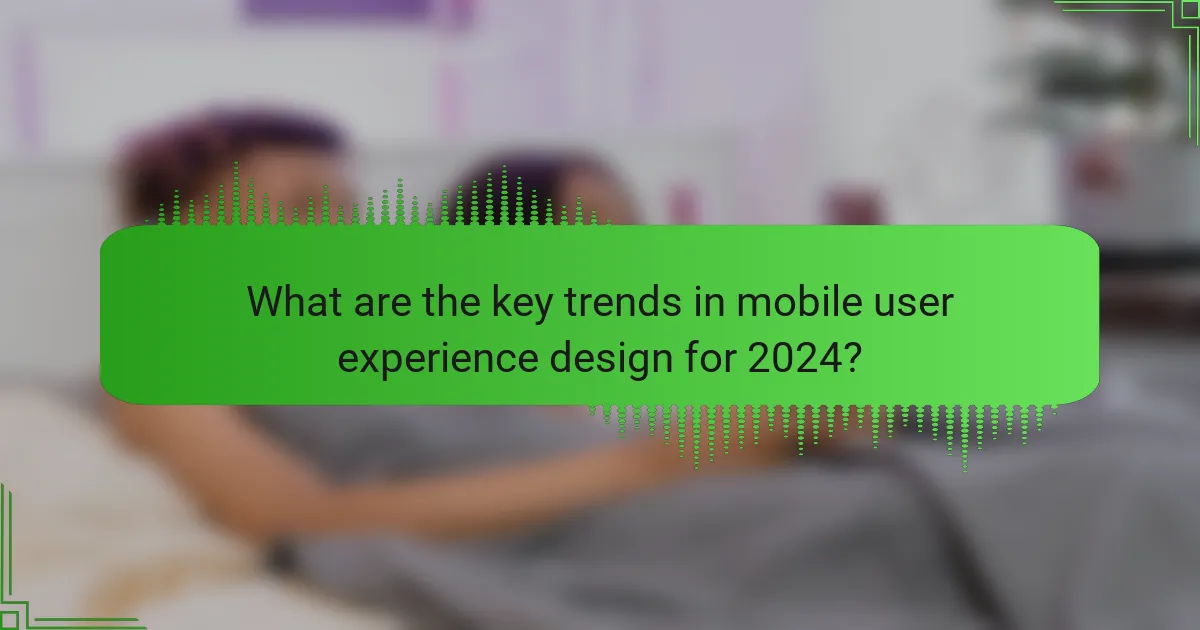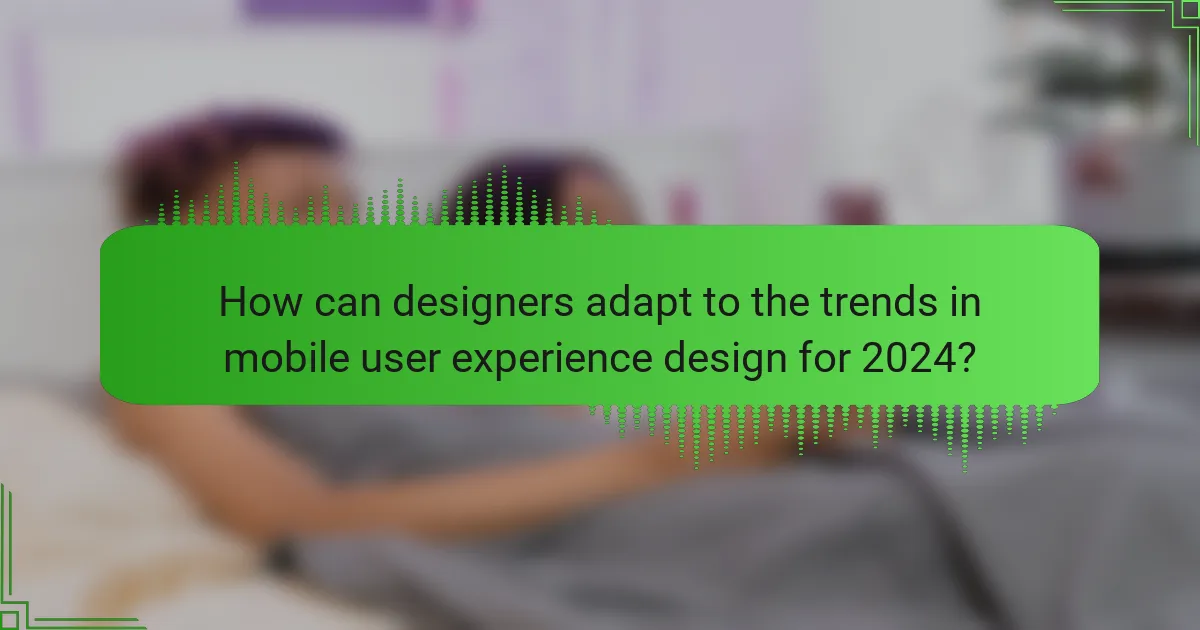Mobile user experience design in 2024 is characterized by key trends such as increased personalization, voice user interface (VUI) integration, and augmented reality (AR) features. Personalization enhances user engagement by delivering tailored content, while VUI allows for seamless navigation through voice commands. AR transforms user interactions by blending digital content with the real world. Additionally, advancements in artificial intelligence (AI) and machine learning (ML) facilitate personalized experiences, and the rise of 5G technology improves connectivity and interaction speed. Designers are encouraged to prioritize accessibility, minimalist design, and emerging technologies to create effective mobile user experiences.

What are the key trends in mobile user experience design for 2024?
Key trends in mobile user experience design for 2024 include increased personalization, voice user interface (VUI) integration, and augmented reality (AR) features. Personalization enhances user engagement through tailored content and experiences. VUI allows users to interact with apps using voice commands, making navigation easier. AR features provide immersive experiences, blending digital content with the real world. Additionally, dark mode remains popular for reducing eye strain. Gesture-based navigation is also gaining traction, offering intuitive controls. These trends reflect the evolving needs and preferences of mobile users in 2024.
How are user expectations evolving in mobile design?
User expectations in mobile design are evolving towards more personalized and intuitive experiences. Users now demand faster load times and seamless navigation. They expect designs that adapt to their preferences and behaviors. Enhanced accessibility features are also becoming a priority. Users increasingly value privacy and security within applications. Interactive elements, such as voice and gesture controls, are gaining traction. Research shows that 70% of users prefer apps with personalized content. This shift reflects a broader trend towards user-centered design in mobile applications.
What factors are influencing changes in user expectations?
Technological advancements are significantly influencing changes in user expectations. Users now demand faster, more intuitive interfaces. The rise of artificial intelligence enhances personalization and responsiveness. Increased mobile device capabilities lead to higher performance standards. Social media trends shape user preferences for design and functionality. Data privacy concerns are prompting users to expect greater transparency. Accessibility features are increasingly seen as essential in mobile applications. Lastly, global connectivity influences expectations for seamless experiences across devices.
How do cultural shifts impact mobile user experience?
Cultural shifts significantly impact mobile user experience by altering user expectations and design preferences. As societies evolve, users increasingly seek personalized and culturally relevant content. For instance, the rise of remote work has led to greater demand for productivity apps that cater to diverse work environments. Additionally, cultural trends influence visual design elements, such as color schemes and typography, which resonate with specific demographics. Research shows that 70% of users prefer interfaces that reflect their cultural backgrounds. Furthermore, shifts in social norms affect privacy concerns, leading to enhanced security features in mobile applications. Overall, understanding cultural dynamics is essential for creating effective mobile user experiences.
Why is personalization becoming crucial in mobile UX design?
Personalization is becoming crucial in mobile UX design because it enhances user engagement and satisfaction. Customized experiences lead to higher retention rates among users. According to a study by Epsilon, 80% of consumers are more likely to make a purchase when brands offer personalized experiences. Personalization allows for tailored content, recommendations, and interfaces that meet individual user needs. This approach not only improves usability but also fosters brand loyalty. As mobile usage continues to grow, prioritizing personalization becomes essential for staying competitive in the market.
What are the main types of personalization strategies for mobile apps?
The main types of personalization strategies for mobile apps include user behavior tracking, content personalization, and contextual personalization. User behavior tracking involves analyzing user interactions to tailor app experiences. This strategy enhances engagement by providing relevant content based on previous actions. Content personalization allows apps to curate information and features based on user preferences. Research shows that 80% of consumers are more likely to make a purchase when brands offer personalized experiences. Contextual personalization adapts app content based on real-time factors like location and time. This approach improves user satisfaction by delivering timely and relevant information.
How does data privacy affect personalization in mobile design?
Data privacy significantly impacts personalization in mobile design by limiting the data available for tailored experiences. When users prioritize privacy, they often restrict app access to personal information. This restriction reduces the ability to collect behavioral data, which is essential for creating personalized content. For instance, a 2021 survey by Pew Research found that 81% of Americans feel that the potential risks of companies collecting their data outweigh the benefits. Consequently, designers must balance personalization with privacy concerns. Techniques such as aggregated data analysis and user-controlled privacy settings can help maintain personalization while respecting user privacy.

What technologies are shaping mobile user experience design in 2024?
Artificial Intelligence (AI) and Machine Learning (ML) are significantly shaping mobile user experience design in 2024. These technologies enable personalized content delivery and enhance user interactions. AI algorithms analyze user behavior to tailor experiences based on preferences. Voice recognition technology is also advancing, allowing users to interact seamlessly through voice commands. Augmented Reality (AR) is transforming how users engage with applications, offering immersive experiences. 5G technology is improving connectivity, enabling faster loading times and smoother interactions. Additionally, biometric authentication enhances security and user convenience. These technologies collectively create a more intuitive and engaging mobile user experience.
How is artificial intelligence being integrated into mobile UX?
Artificial intelligence is being integrated into mobile UX through personalized experiences and predictive analytics. AI algorithms analyze user behavior to tailor content and features. This customization enhances user engagement and satisfaction. For example, AI chatbots provide instant customer support within mobile apps. Additionally, voice recognition technology streamlines navigation and interaction. Machine learning models improve over time, adapting to user preferences. According to a 2023 study by Gartner, 70% of mobile apps are expected to incorporate AI-driven features by 2024. This trend indicates a significant shift towards smarter, more intuitive mobile experiences.
What are the benefits of using AI in mobile design?
AI enhances mobile design by improving user experience and efficiency. It enables personalized content delivery based on user behavior. AI algorithms analyze data to predict user preferences. This leads to more intuitive interfaces that adapt to individual needs. Additionally, AI streamlines the design process through automation. Tasks like prototyping and testing can be expedited. According to a report by McKinsey, companies using AI in design saw a 30% increase in productivity. This demonstrates the tangible benefits of AI integration in mobile design.
How can AI enhance user engagement in mobile applications?
AI can enhance user engagement in mobile applications by personalizing user experiences. It analyzes user behavior and preferences to deliver tailored content. Personalized recommendations increase user satisfaction and retention. AI-driven chatbots provide instant support, improving interaction quality. Natural language processing enables intuitive voice commands for ease of use. Predictive analytics helps in anticipating user needs, enhancing proactive engagement. According to a Salesforce report, 70% of consumers expect personalized experiences. This expectation drives higher engagement rates in mobile applications utilizing AI technologies.
What role does augmented reality play in mobile UX trends?
Augmented reality (AR) enhances mobile user experience (UX) trends by providing immersive and interactive elements. AR allows users to visualize products in their real environment before purchase. This technology improves engagement by creating personalized experiences. According to a 2022 report by Statista, 71% of consumers prefer using AR for product visualization. Companies like IKEA have successfully integrated AR into their apps, allowing users to see furniture in their homes. This trend reflects a shift towards more experiential and user-centered design in mobile applications. As AR technology advances, its role in mobile UX is expected to grow significantly.
How can businesses leverage augmented reality for better user experiences?
Businesses can leverage augmented reality to enhance user experiences by providing immersive and interactive content. Augmented reality allows users to visualize products in their real environment. This can increase engagement and reduce uncertainty in purchasing decisions. For example, furniture retailers like IKEA use AR apps to show how furniture fits in a user’s home. Research indicates that 71% of consumers would shop more often if they could use AR. Additionally, AR can facilitate virtual try-ons in fashion and beauty industries, enhancing customer satisfaction. This technology not only improves user experience but also boosts conversion rates and brand loyalty.
What are some successful examples of AR in mobile apps?
IKEA Place is a successful AR app that allows users to visualize furniture in their homes. This app uses AR to overlay 3D models of furniture in real-time. It helps customers make informed purchasing decisions. Pokémon GO is another prominent example. It integrates AR to create an interactive gaming experience in the real world. Users catch virtual Pokémon in their actual surroundings. Snapchat also successfully employs AR with its filters and lenses. These features enhance user engagement by overlaying fun visuals on users’ faces. These examples demonstrate how AR enhances user experience in mobile apps.

How can designers adapt to the trends in mobile user experience design for 2024?
Designers can adapt to the trends in mobile user experience design for 2024 by focusing on personalization and accessibility. Personalization involves tailoring user experiences based on individual preferences and behaviors. Statistics show that 80% of consumers are more likely to make a purchase when brands offer personalized experiences.
Accessibility should be a priority, ensuring that designs are usable by people with disabilities. Research indicates that 15% of the global population has some form of disability, making accessible design essential.
Incorporating voice user interfaces is another trend. By 2024, it’s projected that 50% of all searches will be voice-based. This shift requires designers to create intuitive voice interactions.
Additionally, designers should embrace minimalist design principles. Studies reveal that users prefer simple, clean interfaces that enhance usability.
Finally, staying updated with emerging technologies, such as augmented reality and AI, will be crucial. These technologies are expected to redefine user interactions in mobile applications. Adapting to these trends will position designers to create effective mobile user experiences in 2024.
What best practices should designers follow for mobile UX in 2024?
Designers should prioritize simplicity and clarity in mobile UX for 2024. Clear navigation enhances user experience significantly. Designers should utilize larger touch targets to improve accessibility. Consistent design elements help users build familiarity with the interface. Fast loading times are crucial; research shows that 53% of mobile users abandon sites that take over three seconds to load. Designers should also optimize for various screen sizes, ensuring responsiveness across devices. Incorporating user feedback into design iterations leads to more user-centered solutions. Finally, integrating dark mode options caters to user preferences and reduces eye strain.
How can designers ensure accessibility in mobile applications?
Designers can ensure accessibility in mobile applications by following established guidelines and best practices. They should use high-contrast colors to enhance readability for users with visual impairments. Implementing scalable text allows users to adjust font sizes according to their needs. Providing alternative text for images ensures that visually impaired users can understand visual content through screen readers. Designers must also ensure that touch targets are large enough for easy interaction, accommodating users with limited dexterity. Using clear and simple language improves comprehension for all users, including those with cognitive disabilities. Testing applications with real users, including those with disabilities, provides valuable feedback for improving accessibility. According to the World Health Organization, over 1 billion people experience some form of disability, highlighting the importance of inclusive design.
What tools can help designers stay updated with mobile UX trends?
Designers can use several tools to stay updated with mobile UX trends. Notable tools include Dribbble, Behance, and Pinterest for design inspiration. These platforms showcase the latest design projects and trends from various designers. Additionally, tools like UX Design Weekly and Smashing Magazine provide curated articles and resources about UX trends. Google Trends can help designers analyze search data related to mobile UX topics. Following industry leaders on social media platforms like Twitter and LinkedIn also offers insights into emerging trends. Finally, attending webinars and conferences such as UXPA International and Interaction Design Association events can provide valuable networking opportunities and trend discussions.
What common challenges do designers face in mobile user experience design?
Designers face several common challenges in mobile user experience design. One major challenge is screen size limitations. Mobile devices have smaller screens compared to desktops, which restricts the amount of content displayed. This requires designers to prioritize essential information and create concise user interfaces.
Another challenge is touch interaction. Unlike desktop environments that utilize mouse clicks, mobile users rely on touch gestures. This necessitates larger tap targets and intuitive gesture controls to prevent user frustration.
Additionally, varying operating systems and devices complicate design consistency. Designers must ensure that their designs function seamlessly across different platforms, like iOS and Android. This often involves additional testing and adjustments.
Network connectivity issues also pose a challenge. Mobile users may experience slow or unstable connections. Designers need to optimize applications for offline use or low-bandwidth scenarios to enhance user experience.
Lastly, user diversity presents a challenge. Designers must consider varying user preferences, ages, and abilities. This requires inclusive design practices to cater to a broad audience effectively.
How can designers overcome usability issues in mobile apps?
Designers can overcome usability issues in mobile apps by implementing user-centered design principles. These principles focus on understanding user needs and behaviors through research and testing. Conducting usability testing helps identify pain points in app navigation and interaction. Iterative design allows for continuous improvement based on user feedback. Simplifying user interfaces reduces cognitive load, making navigation intuitive. Designers should prioritize accessibility to accommodate diverse user needs. Utilizing design systems ensures consistency across app elements, enhancing usability. Analytics tools can track user behavior, providing insights for further enhancements. Overall, a focus on user experience leads to more effective mobile app design.
What strategies can be employed to address performance concerns in mobile UX?
To address performance concerns in mobile UX, developers can implement several strategies. Optimizing image sizes can significantly reduce load times. Utilizing lazy loading techniques ensures that content is loaded only when needed. Reducing the number of HTTP requests minimizes the time taken to fetch resources. Implementing efficient caching strategies can enhance performance by storing frequently accessed data. Streamlining code through minification and compression decreases file sizes. Using a Content Delivery Network (CDN) can improve response times by distributing content closer to users. Prioritizing mobile-first design ensures that the user experience is tailored for mobile devices. Regular performance testing can help identify and rectify issues promptly. These strategies collectively enhance mobile UX performance, leading to better user satisfaction and engagement.
What tips can enhance the mobile user experience in 2024?
Optimize mobile design for speed. Users expect fast loading times. Aim for under three seconds to retain engagement. Implement lazy loading for images and videos. This technique improves initial load times. Use efficient coding practices to reduce file sizes. Streamline user interfaces for clarity. Simple designs enhance usability. Prioritize touch-friendly elements for easier navigation. Ensure buttons are large enough for interaction. Incorporate voice search features. Voice search is increasingly popular among mobile users. Leverage AI for personalized experiences. Tailored content increases user satisfaction. Regularly test mobile usability with real users. User feedback provides valuable insights for improvements.
Trends in Mobile User Experience Design for 2024 focus on key advancements such as increased personalization, voice user interface (VUI) integration, and augmented reality (AR) features. The article explores how user expectations are evolving towards more intuitive and accessible designs, driven by technological advancements and cultural shifts. It highlights the significance of personalization strategies, the impact of data privacy on user experiences, and the role of AI and AR in enhancing engagement. Additionally, best practices for designers and common challenges faced in mobile UX design are discussed, providing a comprehensive overview of the current landscape and future directions in mobile user experience.


